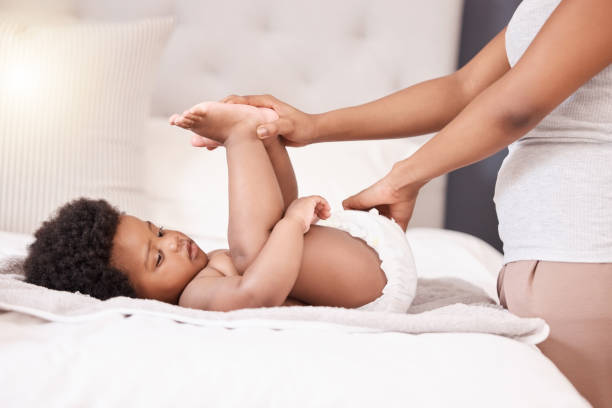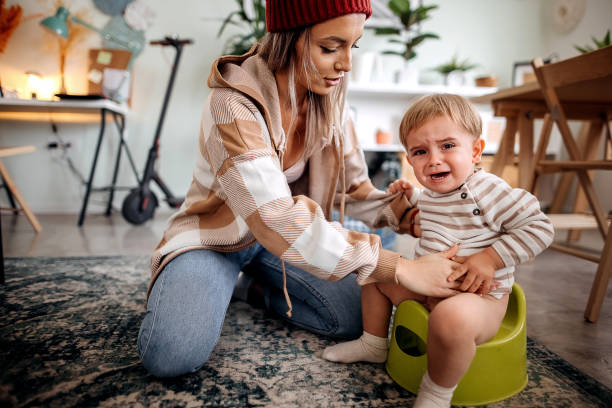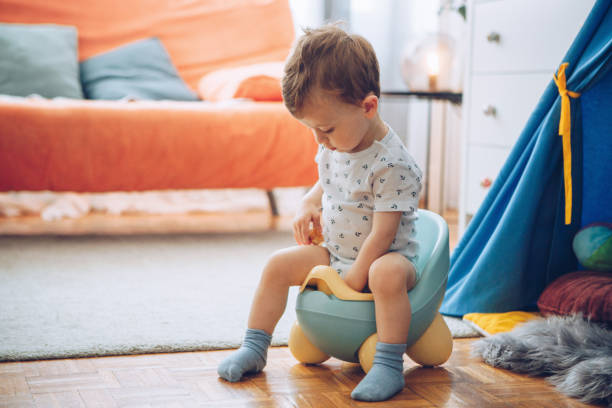The 3-Day Potty Training Secrets Unlocked.

“Can I potty train my baby in three days?” This is one of the most asked questions by parents, especially first-timers.
Parents are always curious about transitioning their children from diapers to potty training. What is more interesting is that they hope to achieve this feat cold turkey.
The 3-day potty training approach has gained massive popularity, and every “parenting coach” seems to recommend it for their potty-training boot camp.
According to the 3-day potty training philosophy, your baby should stay diaper-free for three days while learning to use the potty.
Proponents of the 3-day potty training approach hold that this crash approach yields better results than gradual potty training techniques.
When Should You Start Potty Training A Baby?

There is no specific timeline for when a baby is ready for potty training. Some babies can show readiness for potty training from as early as 18-21 months (approximately one year, 8 months).
In other cases, your baby might get ready to be potty trained when they are 36 months old (3 years old). The American Academy of Family Physicians states that 40-60% of babies learn how to use the toilet at three years. If your baby is in this category, stop worrying.
What Are The Signs of Readiness For Potty Training In Babies?
These are the tale-tell signs of readiness for potty training in babies:
1. Routine Development
A baby might become uncomfortable when they want to pee or poop. In other cases, they might touch their private parts just before emptying their bowels or bladder. If you notice these signs over a certain period, it is time to potty train them.
2. Muscle Mastery
Another sign that your baby is ready for potty training is when they start taking off their clothes just before relieving themselves. They might also walk to the bathroom just before the big event.

3. Curiosity About The Potty
If you have bought a potty for your baby, you will likely see them showing curiosity about it. They could take off their pants or diapers and sit on it. Even if they fail to relieve themselves, that should tell you to start training them on its usage.
4. Body Awareness
Another way to tell you that a baby is ready to be potty trained is when they become aware of their actions. In some cases, your baby might hide themselves when they start peeing or pooping. Have you also encountered an event where the baby appeared shy or guilty of relieving themselves?
If you encounter any of these “abnormal” behaviors from your baby, potty train them.
5. Dislike For Dirtiness
If your baby feels gross after peeing or pooping, enrol them for the 3-day potty training “class”. You might see your baby holding their nose after pooping or peeing on their pants or diapers.
In other cases, you might see the baby trying to remove soiled or wet diapers. At times, a ready-to-potty-train baby will always cry when they are wet or have soiled their clothes.
What Are The Benefits Of 3-Day Potty Training?
What is all the fuss about 3-day potty training? You might ask yourself.
Parents derive many benefits from training their babies on how to use the potty in three days. This is a summary of some of the benefits of 3-day potty training:
Less laundry to clean- Ditching cloth diapers for the potty means you will wash fewer clothes.
Saving on money- Potty training your baby means that you will no longer spend money on diapers. Healthy Children estimates that on average, a baby in the U.S spends about 3,000 diapers in the first year.

Saving the environment—Diapers are huge contributors to the landfill menace. Over 18 billion diapers end up in landfills every single year. If you are environment-conscious, which you should, ditch the diaper by potty training your baby.
Parenting freedom- Potty training your baby means that you don’t have to wrestle your big baby to change their diapers.
What Are The 3-Day Potty Training Requirements?
For a successful 3-day potty training, you will be required to be wise. These are the best potty training tips to use:
a) Rewards
Rewarding your baby any time they successfully use the potty motivates them and challenges them to try more and more. You can reward them by giving them their favorite toys or snacks.

You can also deviate from the conventional reward system by clapping for them, heaping them with praise, hugging them, and giving them high-fives.
Any time the baby succeeds in the potty, you reward them. Reduce the frequency of rewarding them from a single potty use to a day, a week, etc.
The reward system is controversial and has raised opposition from strong adherents to the 3-day potty training challenge. They argue that rewarding the baby for using a potty is similar to bribing them.
According to these opponents, once a baby gets accustomed to getting rewards for using the potty, they become entitled. Failure to reward the baby makes them soil or wet themselves to “punish” you.
b) Potty Chair
Having a potty chair for your baby is the first step towards a successful three-day potty training session. A potty chair prepares your baby mentally for what lies ahead.
When choosing a potty chair for your baby, consider its design. Many sophisticated potty chairs are available, but unfortunately, most of them are not ideal for your baby.
Go for a low potty chair to support the baby’s feet on the floor. This design activates the baby’s lower pelvic area and strengthens its mobility.
c) Underwear

The subject of your baby having underwear is controversial. Opponents of its use argue that underwear would distract the baby from learning how to use the potty.
On the other hand, proponents of dressing the baby in underwear argue that it is a way of reducing pooping and peeing all over. The proponents also argue that when a baby is in an underwear (please note: not a diaper), they become more aware of their environment and avoid pooping around.
Both arguments hold water, and as a parent, you should choose what fits you.
d) Adequate Food And Drinks
The 3-day potty training program involves spending three days supervising your baby and training the baby as many times as possible.
Give your baby as much food and fluids as possible to increase the success of the 3-day potty training routine.
The Six Steps Of 3-Day Potty Training Technique
This is a step-by-step on how to implement the potty training program in three days:
Step 1: Preparing Your Child
As mentioned earlier, babies can use different types of potties and potty chairs. You can use the standard potty chair or a kid-size potty-seat insert. If you opt for the latter, you should also have a step stool to help them easily reach the standard household toilet seat.

You also need to mentally prepare your child by telling them they will be using the potty.
Are you nuts? Babies can’t talk or understand, for goodness sake! You might assume. The funny thing is that babies understand simple words. Keep repeating the word “potty” until it sticks to their mind.
Step 2: Ditching the Diapers

Take the baby’s diapers away and let them stay bottom-naked.
When the bottoms are naked, children become more aware of their bodies easily and avoid messing around. At first, the baby might mess around from time to time. However, by the end of the three days, babies become more sensitive to wet or soiled naked bottoms.
During the winter, you can turn on the heater and dress them in training pants, dresses, or pants with elastic waistbands.
Step 3: Add More Fluids
Adding more fluids to the baby’s fruits makes them pee more. As the train, more peeing means that you get more time to potty train them and increase their success levels.
The best fluids to give your baby when potty training them include water, watermelon, and popsicles.
Step 4: Observe Them

During the three days, be more attentive and note when they are about to empty their bowel or bladder.
The most common signs of a baby who is about to relieve themselves include:
- Passing gas (it could be due to constipation)
- Showing a vacant expression or being panicky
- A red face
- Producing funny sounds such as grunting
- Pausing from playing or watching their favourite program
Once you see the baby displaying these signs, you can tease them by pretending to sit on the potty. This strategy creates awareness for the baby and encourages them to use the potty more.
Step 5: Creating A Potty Routine
During the three days of potty training, your baby creates a routine they can easily follow. After the baby wakes up, take them to the bathroom to relieve their pressed bladder. Do the same before and after they nap or sleep. After meals, do the same.
Using this strategy is very effective since it sticks into their heads fast.
Step 6: Prepare For Accidents

During the 3-day potty training challenge, accidents are bound to happen. After all, your baby is learning how to use the potty. Any time the baby messes with the potty and the surroundings, correct them with love using demonstrations.
How Do You Measure The Success Of The 3-Day Potty Training?
As a parent, the word, Patience, should appear more in your vocabulary. You will need it. A lot.
You cannot successfully potty train your baby in three days. The three days are just the start of a long journey.
Your child is likely to mess up once. Or twice. And more. You will be left frustrated. Angry. Disappointed.
Bottom Line
Potty training is a calling that requires patience and keenness with your baby. Step by step, one mess after another, your baby will surely know how to use the potty.